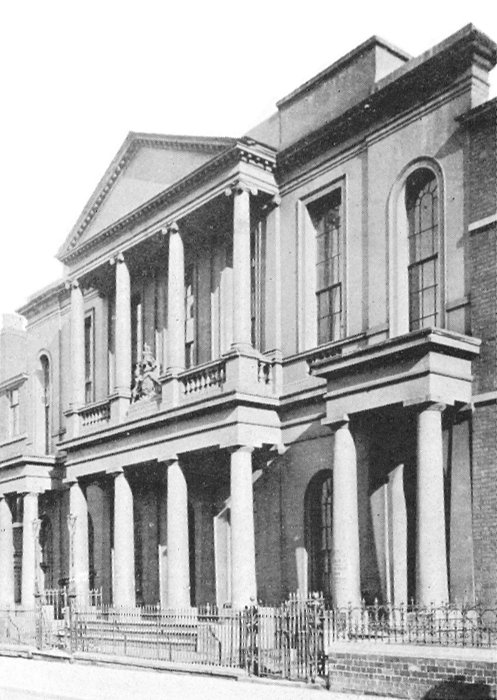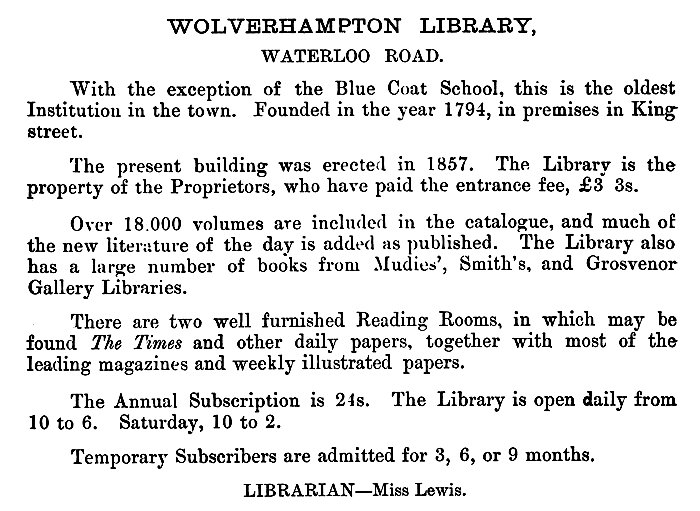|
Early Subscription
Libraries
It all began in about 1794 in two
front rooms of a private house in King Street, which
belonged to William Tildesley, who acted as librarian
for an annual payment of 20 guineas, which included the
rent for the rooms. As the number of subscribers to the
library increased, so did the number of books. The
library was run by a management committee formed of
twelve subscribers with a president in charge. A
shortage of space became a problem and so in January
1810, the committee decided to erect a set of shelves in
the reading room and to pay Mr. Tildesley the sum of
five pounds for any damage caused to his property. A few
days later at a special general meeting, held at the
Castle Inn, the subscribers unanimously voted for the
erection of a library building, but it was put on hold
for several years because of worry about the effects of
the war with
Napoleon.
At the annual general meeting of
the subscribers, on Saturday 31st December, 1814 it was
finally decided that the building of the new library
should go ahead and soon a piece of land was purchased
on the south side of Queen Street, from Mr. T. H. Ward.
When Mr. Tildesley heard of the
decision to move the library to Queen Street, he
unexpectedly gave the committee notice to remove the
library from his house by the 31st September, 1814. The
committee then retaliated. A letter from the management
committee president, Mr. G. W. Kempson was sent to Mr.
Tildesley to inform him that his services as librarian
would end on the same date. The library then moved to
another house in King Street, where it remained until
the new library was built.
It was built as a single storey building, the upper
floor being added a few years later. The following
minute from the committee’s meeting on the 13th
November, 1815, describes the proposed layout for the
library and the rent, charged by the proprietor: |
| That, at a meeting of the committee held
this day, the general body of subscribers in
the annual meeting assembled on the 31st
December, 1814, having authorised the
president and committee to treat with the
committee for building the library in Queen
Street, and that building being now nearly
completed, it is hereby unanimously
determined to take three rooms in the said
new building for the use of the library; one
room for the books, another for the
reading-room, and the third for the
librarian's sitting room; the tenancy to
commence on the 1st of January, 1816, at a
rent of £35 per annum, that being the amount
demanded by the proprietors of the said
building; and that orders be given to
prepare what new shelving is necessary. |
|
| The proposition was considered at the next
subscriber’s meeting on the 30th December, 1815, and was
unanimously accepted. It was also decided that annual
subscription would be increased by one guinea and that
the admission fee for all new subscribers would be
raised to two guineas. The newsroom and the library
would open each day, except Sunday, from eleven o’clock
to one o’clock in the morning and from two o’clock until
5 o’clock in the afternoon. The first librarian was Mrs.
Walker, who was employed at a salary of 40 guineas per
year. Her duties included cleaning, lighting and looking
after the fires. She soon left and was replaced by Miss
Bevan, whose salary soon increased to 50 guineas per
year. There were 268 subscribers, who provided an annual income of £362.12s.4d. |
|

Queen Street Library, later the
County Court. |
The number of subscribers and the number of books greatly increased. The proprietors agreed to
add a second story to cope with the need for more space.
The upper storey was built in 1830 and 1831. Miss
Bevan left in July 1833 and was succeeded by Miss
Simpson.
In July 1847, Miss Simpson complained about the lack
of room for the expanding collection of books. The
library only used some of the rooms on the upper floor
and wanted to rent all of them.
When the upper floor had been built, the annual rent
increased to £60, but the proprietors wanted a rent of
£100 for the use of all of the rooms.
For some time the proprietors and the library
committee had disagreed about the charge for rent. As a
result, the proprietors decided to sell the building to
the government for use as a county court.
In October 1856 the library committee was informed
that the library had to vacate the building at short
notice. |
| The library committee formed a sub-committee of
subscribers to form a limited company under the name of
the Wolverhampton Library New Building Company Limited,
which issued shares to raise the money for the building
of a replacement library. A sum of £2,000 was soon
raised and a suitable piece of land was purchased on the
west side of Waterloo Road. The tenancy in Queen Street
was given up at the end of 1857 and in early 1858 the
contents of the library were moved to Waterloo Road. |
|

Waterloo Road Library. |
|
In 1866, Miss Simpson left and was
replaced by Mrs. Sarah Cooper. Things went well until
early 1876 when the costs of running the library
outweighed the income. It was eventually agreed that the
building company should go into voluntary liquidation
and sell the company’s assets, consisting of the
building and the land etc. to the proprietors of the
library. This took place in December 1890 after £600 had
been borrowed on a mortgage for the building. In 1896,
Mrs. Sarah Cooper died and was replaced by Miss Lewis. |
|

From the 1908 Wolverhampton Red
Book. |
|
The library survived until about 1910. The building
was later used for the Wolverhampton Library and Ladies’
Club. |
 |
|
 |
Return to
the contents |
|
Proceed to the
Mechanics' Institute |
|